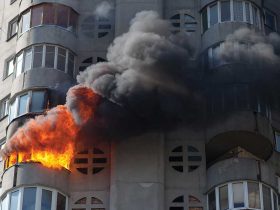Australia is a country that has a variety of terrains from the tropical regions of the north to the mountains in the south. In February 2009, Victoria experienced one of the natural disasters that result from bushfires that become out of control. All of Victoria had reached the 40°C (104°F) temperatures in many areas by 11 a. m., along with hot northerly winds that would create havoc upon Victorians for many weeks to come.

Photo 1. This view shows the hills of Kinglake where the fire passed through and it is encouraging to see the grass that has re-grown. All the hills in the photo suffered and, as you have heard, many homes and businesses were lost.
The outpouring of many from around the world as Victoria suffered was incredible, and it was really humbling to see the money that was raised; the world seemed a smaller world with all this support. For those who have been involved in fires, much will not surprise you; however, it is important to understand how the Australia bush and attitudes have survived through all this tragedy.
If we look at some of the areas that were affected, at this six month mark, it is incredible to understand the extent of the area that suffered.

Photo 2. Transmission line easement at Coldstream. For Melbourne, this region is one of the areas that provide one of the supply lines to the metropolitan electricity supply and, as you can see, the area around the electricity towers was on fire.
As we see events like this it is important to understand what it is that we can do within the electrical industry. Once the fires had passed, the electrical industry pulled together to provide voluntary electrical contractors and electrical inspectors to assist in restoring the power to the base infrastructure.
Energy Safe Victoria, the electrical regulator, assisted by providing guidance on the connections of generators to ensure that the affected people could have these installations made compliant and safely. The requirements for licensed electrical inspectors that were certified for generators was relaxed to ensure that many more licensed electrical inspectors could assist.

Photo 3. Home site at Toolangi. For some people there was nothing left and a complete home is required to be built. For the current situation some people have been provided with caravans and can be seen in this photo.
In Retrospect
“On Saturday 7 February 2009, Australia experienced its worst natural disaster in more than 100 years, when catastrophic bushfires killed more than 200 people and destroyed more than 1800 homes in Victoria, Australia. These fires occurred on a day of unprecedented high temperatures in south-east Australia, part of a heat wave that started 10 days earlier, and a record dry spell…. Unfortunately, it appears that one or more of the fires may have been lit by arsonists, others may have started by accident and some may have been started by fallen power lines, lightning or other natural causes.”
— Guest commentary by David Karoly, Professor of Meteorology at the University of Melbourne in Australia on Climate Science, 16 February 2009.

Photo 4. Kinglake village. For those where this is not possible, there has been the development of temporary villages on farm lands at the edge of the town. Here we can see a village that has been established in the Kinglake area.
If we consider these installations, there has been a main switchboard established on the property boundary and then all other services have been reticulated via underground supplies. There has also been the use of solar panels, which can be seen on the roofs, to reduce the demand requirements on the electrical system. Whilst I was there, they were still installing new buildings to cope with the demand so the work will remain ongoing for much longer yet.

Photo 5. Current HV overhead supply with LV underground connection. Current construction of the power distribution system still relies on the high-voltage system being installed overhead, rather than through an underground. Here is the current system that is being used.
Once you leave the suburban areas, the customer connection is taken via an underground connection as can be seen by the black Fused Overhead Line Connection Box (FOLCB) about one third up the pole.
The distribution company is responsible for providing the pole and equipment down to the FOLCB, whereas the electrical contractor is required to install the underground service up the pole including the FOLCB.
Likewise the HV overhead system has all the relevant protection systems that will detect potential faults that would allow for the system to operate and remove supply and the potential risk.

Photo 6. Fighting attitude. Through all these events, the true Australian culture will prevail. As I left the area, I saw this sign which summed up the attitude.










Find Us on Socials